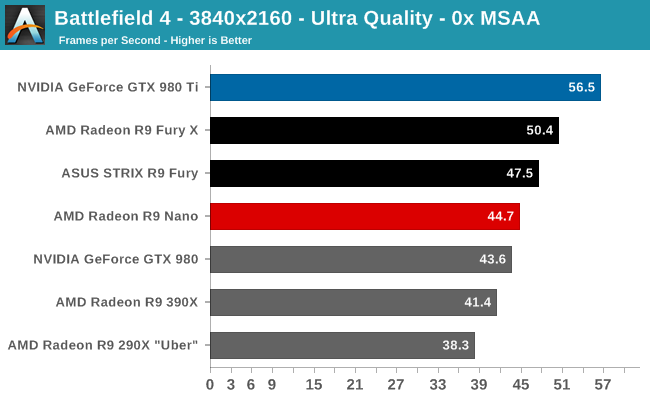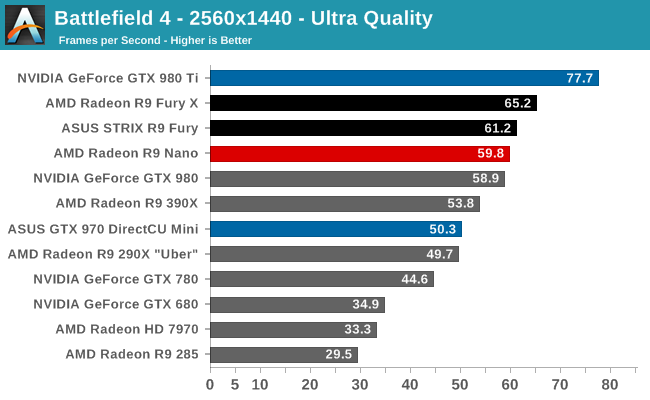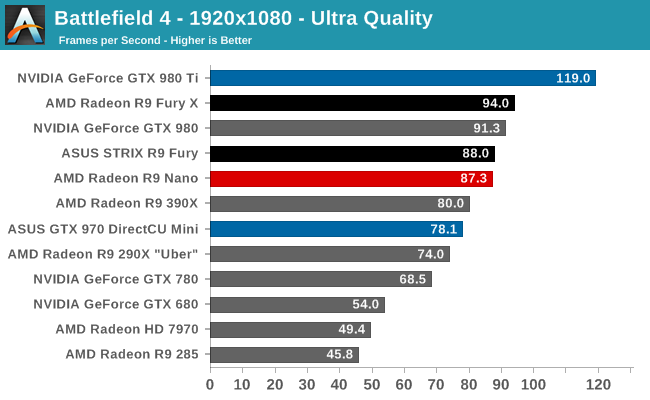The AMD Radeon R9 Nano Review: The Power of Size
by Ryan Smith on September 10, 2015 8:00 AM ESTBattlefield 4
Kicking off our benchmark suite is Battlefield 4, DICE’s 2013 multiplayer military shooter. After a rocky start, Battlefield 4 has since become a challenging game in its own right and a showcase title for low-level graphics APIs. As these benchmarks are from single player mode, based on our experiences our rule of thumb here is that multiplayer framerates will dip to half our single player framerates, which means a card needs to be able to average at least 60fps if it’s to be able to hold up in multiplayer.




Like the other Fiji cards, AMD is promoting the R9 Nano in part on its 4K capabilities. And while we disagree that this card is suitable for 4K gaming based on its sub-Fury performance, we’re including 4K results anyhow to serve as a point of comparison.
In any case Battlefield 4 is often a good indicator of general card performance, and for the R9 Nano this is no exception. What we find is that the R9 Nano trails the other Fury cards in all cases. However to our initial surprise, the R9 Nano sticks rather close to the R9 Fury. The petite powerhouse trails the R9 Fury by only 1-6%, which for the record is a smaller gap than we were expecting.
While the R9 Nano packs a full Fiji GPU, AMD has to pull back on clockspeeds to hit their power targets; in the case of Battlefield 4 this is an average clockspeed of just 879MHz at 2560x1440. Given this we had been expecting the R9 Nano to deliver around 85-90% of the performance of the R9 Fury (and about 80% of the R9 Fury X), based on the assumption that average clockspeeds would be closer to 800MHz. So the fact that the R9 Nano starts off as close to the R9 Fury as it does – even if it’s still trailing it – is a pleasant surprise.
Otherwise with performance still clearly occupying a position as a “3rd tier” Fiji card, I’m not sure if anything about these results should be surprising. On a price/performance basis AMD is not intending to be competitive with other $650 cards, so the R9 Fury X and GTX 980 Ti are of course on the top of the heap. What you get instead is a card that delivers around 90% of R9 Fury X’s performance in BF4 with much less power consumption.
Moving on, compared to the lower power and smaller cards, the R9 Nano is as expected a clean sweep. Demonstrating the virtues of a wide and lower clocked processor’s ability to deliver strong performance without requiring extreme power, everything from the R9 285 to the GTX 980 trails the R9 Nano here. Compared to the GTX 970 Mini in particular, the R9 Nano is 12-26% faster depending on the resolution.
The one potential problem here for the R9 Nano is the GTX 980. Though not a Mini-ITX card, the GTX 980’s power consumption is going to be fairly close to the R9 Nano’s, definitely more so than GTX 970’s. From a power efficiency standpoint it’s the GTX 980 that poses the greatest challenge to the R9 Nano, and while it’s ahead of the GTX 980 in this case at 2560x1440 and higher, it’s a sign that AMD should be worried about what could happen if an NVIDIA partner produced a Mini-ITX GTX 980.










284 Comments
View All Comments
zodiacfml - Saturday, September 12, 2015 - link
Yawnn.. It's not bad till you get to the price. Fury X now has better value as you get watercooling.paravorheim - Saturday, September 12, 2015 - link
"Meanwhile Fury X’s massive power headroom has been significantly curtailed, from a TBP of 275W (and in practice a cap much higher than that) to a much harder TBP limit of 175W for the R9 Nano."You say TBP here, is that supposed to be "TDP"? I saw it in a few other places as well.
SunnyNW - Monday, September 14, 2015 - link
TBP (Thermal Board Power) vs TDP (Thermal Design Power)The0ne - Monday, September 14, 2015 - link
Bin parts for power and cooling efficiency instead of a good design isn't something to rave about. It should be something to write off of because, lets faced it, nothing is different from the previous designs.medi03 - Monday, September 14, 2015 - link
Yeah, "previous designs". Like 290x that beat that day Titan at a fraction of price.Gnomer87 - Tuesday, September 15, 2015 - link
While an improvement in the efficiency segment, this card still loses out to Nvidias alternatives, most notably the older 980. The 980 performs only marginally worse, while having a smaller price tag.It's still a walkover, if I were to replace my hd 7950b today, it'd still be nvidia. This is a problem, if AMD doesn't get their shit together, they're going bankrupt.
And that means monopoly.
Oxford Guy - Tuesday, September 15, 2015 - link
Is there a 980 in this form factor? If not, then it doesn't lose because there is an AMD card that outperforms the 980 for less money as far as I know.IlllI - Tuesday, September 15, 2015 - link
love the nano, can't justify the price. up until now i thought it was going to be $499. the Fury X i can justify the price b/c you can look at it as having a $100 liquid cooler included. but for the nano to be the same price as the Fury X.. I just can't.gw74 - Wednesday, September 16, 2015 - link
AMD_Roy twitter account has been deleted!JonnyDough - Tuesday, September 22, 2015 - link
Wow, lots of crap in the comment's section. I'll post my own. Smaller is better. The trend of hotter, louder, heavier, and more energy guzzling cards was terrible. Not only did it KILL some of my PCI-E slots after awhile from the sheer weight of the card, but most of the old hot running cards are now dead and don't work. It's nice to see a nano card that can fit in an ITX case comfortably. Here's to LAN parties of the future, and more room on/under desks!